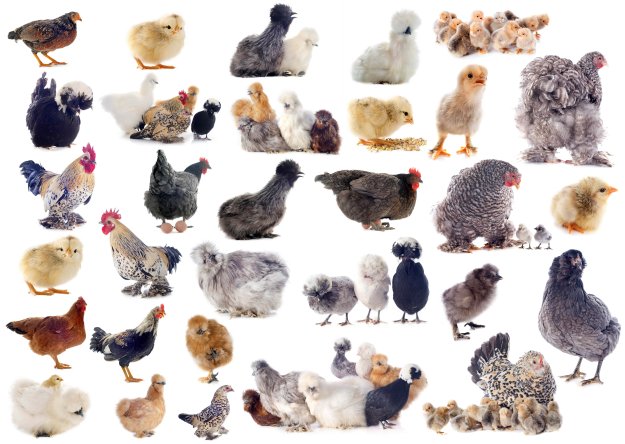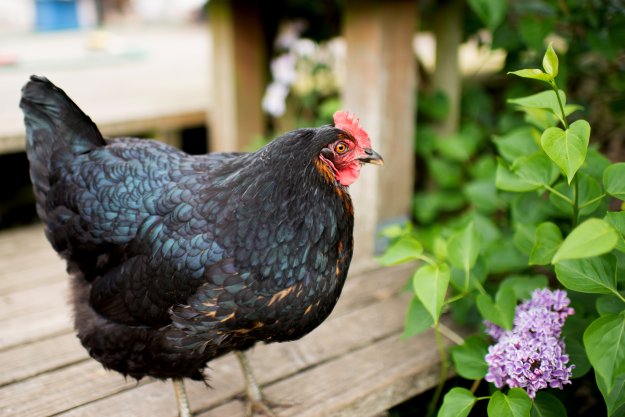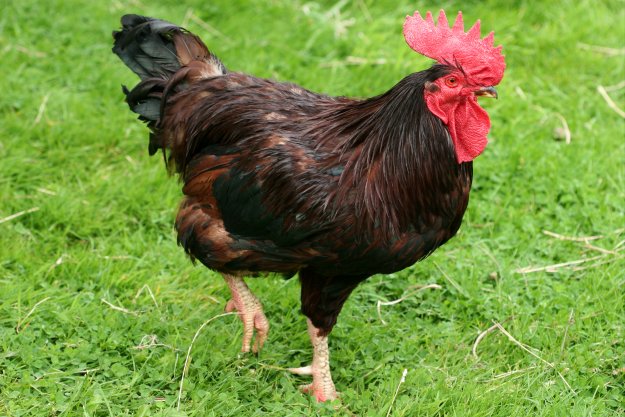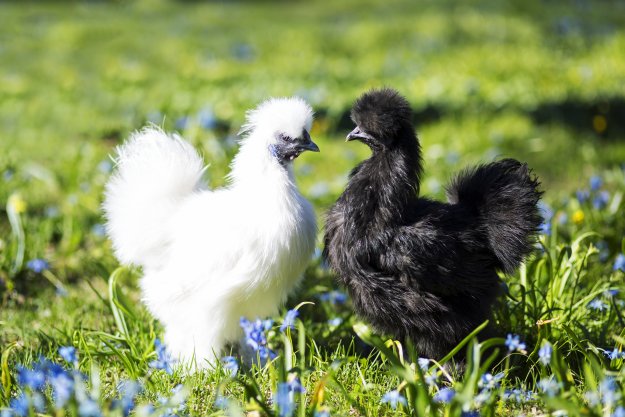If you plan on raising backyard chickens, you should think about what chicken breeds would be best for you. Different types of chickens have different personalities and different needs. Keep reading to learn them all…
You are reading Chapter 1 of our Homestead Handbook:
Raising Backyard Chickens
Chapter 1:
Chicken Breeds
Decisions, Decisions. Now this is where the fun really begins – when you finally get to figure out the perfect breed and characteristics that will fit you. Unfortunately, it is not something that is as simple as a stroll in the park; it'll take a bit of researching on your part. Do you happen to live in an area that snows and are aware which breeds would be able to tolerate it? Are you looking for more of an indoor ‘pet' which requires a bit of human assistance regularly or an outdoor worker who is pretty self-sufficient on its own? Are you aware which breeds have a known temperament over those that are generally sweet? Believe it or not, there are also certain breeds who would sooner the chew broken glass of your winder than sit around all day on their eggs though it is something most normal chicken do. Even finer details such as their color, feather pattern, and noise level are attributes that can be taken into consideration. When you are mentally equipped with knowledge, nothing will come up to you as too much of a surprise.
1.1 – Types of chicken breeds
A breed is defined as a specific group of domesticated animals who share similar genetics in regards to appearance, characteristics and behavior which separate them from another group of the same species. According to the America Poultry Association (APA), established in 1987, there are well over a hundred breeds that are recognized and categorized accordingly. Within a given breed, all chicken tend to carry the same feathering arrangement, number of toes and like skin color. The APA separates two classifications of breeds known: the bantam or large. Bantam breeds are miniature, quarter-sized versions of its counterpart and, therefore, does not need as much space as the large breeds do. A true bantam, however, has no other counterpart. These lovable little creatures are rapidly becoming infamous as pets or displaying at shows due to the beautifully patterned feather and exotic colors that they possess. Their diet is grain-based, which makes things pretty convenient for the owner.

Looking at a birds' feathering, or lack thereof, is a common method used to identify the bantam breed it belongs to. The patterns are known as spangled, striped, edged, stippled, Millefleur, barred, laced and penciled. Bantams are also accustomed to laying eggs, as high as twelve dozens in a single day though the eggs are often a third of the size normal eggs are. Other than relying on outward appearance, there are six characteristics bantam breeds are classified as in regards to their appearance: modern game; game; rose comb, clean legged; single comb, clean legged; feather legged and all other comb, clean legged. Modern game is an ornamental breed that originated in the mid 1800’s from England and was used for cockfights – not really a personal favorite of mine – and the game class simply consists of the remainder not classified. A comb is the flap like growth on top of a chicken's head and is very pronounced more so in males. So a single comb, clean legged breed is one with one comb atop its head and no feathers covering its feet. Compared to the single comb, a rose comb is generally flatter situated on top of the head. The other known types of combs a breed can possess are labeled as pea, strawberry, cushion, silkie, carnation, buttercup, walnut or V-shaped.
The second classification, known as large breeds, is also divided into six classifications are determined by where they originated: American, Continental, Asiatic, English, Mediterranean and other. The American Class consists of thirteen breeds which originated from either the United States or Canada. These chickens, like the Plymouth Rocks, are massive breeds that typically lay large, brown eggs. This class is reputed as being able to withstand the cold climates, namely the Chantecler and Buckeye. The Continental Class includes ten breeds of chicken that originated from mainland Europe and are labeled as incredibly sprightly and full of energy with the exception of Favorolles. If you are looking for a vivacious personality, these babies will certainly be perfect for you. The Asiatic Class is the smallest class, consisting of only three breeds which originated from China. They are large, feathered birds which are commonly hailed as perfect house pets due to their gentle nature and quiet persona. The Brahmas, the largest of the three, are not the type to venture off like a child. If you were to raise one that debunked this, fear not; their extra weight won’t allow them to fly anywhere. They are awesome champs too and can lay plenty of brown eggs for you. In contrast, Cochins aren't the best egg layers whereas Langham's (black or white) or perfect if you are looking to breed for meat. The English Class is made up of breeds which originated in Australia and the United Kingdom. These breeds all have pink skin and lay brown eggs other than Redcap, it lays white eggs. The Mediterranean Class originate from, of course, the Mediterranean region and have a group of seven breeds who all possess white earlobes and are the best-known eggs layers around until the day someone else decides to steal the trophy. The other classes do not fit the other classes, and it is further subdivided between game and oriental. Although I already brushed over certain qualities to expect in certain breeds, I still want to label four specific categories most people go for when deciding to raise a chicken and provide a broader list of options for those interested primarily in layer, meat, dual-purpose or ornamental breeds.
Layer breeds are known for their incredible ability to lay eggs all day, every day so long as they are young and healthy. Your life will never be the same again once you've had a taste of homegrown eggs. You will never want to go back to store bought eggs after witnessing its deep, rich color and supreme flavor. Layers produce about 200-300 egg per year, which some are exceeding that. Ideally the best layers are smaller in build requiring little food to sustain muscle mass, start laying around four months of age and do not commonly nest ( those that stop laying eggs and becomes more interested in hatching them). Also for those curious, contrary to belief, there's no significant difference between white and brown eggs, they hold the same nutritional value. The color varies strictly because of the various breeds although there is a slight difference in taste. If you hold a specific interest in raising chicken solely for eggs, consider these breeds:
- Leghorn (white)
- Ancona
- Minorca
- Andalusians
- Spanish
- Catalana

Meat Breeds are characteristically ideal when the chicken are able to mature and feather rapidly, meet target weight in minimal time span, have white feathers for cleaner feather picking and are broad-breasted. Those who are concerned about the chicken commercially grown and are looking for a safer option may choose to raise them on their own. Home raised meat is healthier over those sold in stores as it contains less fat, and it is tastier.
- Cornish
- Shamo
- Jersey Giants
- Brahma
- Langsham

Dual-Purpose Breeds is a match made in heaven for those who want the best of both: meat and eggs and there are two ways to come about this. You could raise both laying breeds throughout the year and meat birds on the side as they are needed, or another option would be just to raise dual-purpose breeds, which most people do. The main advantage to raising dual-purpose breeds is because they lay better compared to meat breeds and grows larger than layer breeds. However, they still do not grow as fast or big in comparison to meat birds nor do they lay as often as laying birds are able to do. Many still do not find this to be a negative when they are raising the chicken on their own over general farm producers whose main concern is earning money quickly and profitably. The English and American breed fit this type.
- Rhode Island Reds
- Plymouth Rocks
- Wyandottes
- Orpingtons
- Sussex
- Australorp

Ornamental Breeds are birds that are raised purely for aesthetic reasons and not for production. These chickens are shown off at poultry exhibitions to show off their features. Every exhibition holds a model standard, describing what they deem to be the ideal look, size or shape for a breed and the breed that can come close to meeting that ideal is dubbed as ‘true to type. As mentioned earlier, bantams are commonly raised for ornamental reasons.
- Coshin
- Bantam

1.2 – Going For a Pure or Mixed Chicken
Most people are curious about the differences, if any, between a purebred and hybrid and whether or not it makes a difference to pick on over the other for those who want good egg layers or meat producers. A great deal of deciding on which of the two you should go for depends on whether or not you plan to hatch the eggs produced. Unlike purebred offspring who grow up to be genetically the same as their parents, hybrids are not. This is because they are a product of two different breeds, and the only method to produce more like them would be to reproduce the exact cross they originated from. Learning about what exactly pure, hybrid and strains are important to those who wish to procreate further their flock. A strain is a family of related birds that are bred whilst keeping specific traits in mind that the owner is looking for. Breeders may choose to outcross with a different breed in order to either refrain from inbreeding (breeding closely related animals) or improve a particular characteristic such as feathering for aesthetic purposes.
Commercial production lines usually raise hybrids from two different breeds specifically for better meat or egg production. Commercial white egg layers are often not hybrids, and the brown egg layered eggs are often a result of true hybrids as well as most meat strains. Generally, purebred brown eggs lay fewer eggs compared to the commercial hybrids. If you are thinking about raising hybrid birds for meat, it is usually an easy short-term project. You simply purchase a few hybrid chicks such as the Cornish cross and feed them until they are ready to be cleaned and cooked. This is completed relatively quickly whereas purebreds are not. Although they can mature to be a decent size, they have a slower growth rate. Even though they do not grow as quickly, there still is some positive to know the meat is also much tastier because it had more time to grow. This is foreign and likely gibberish to many uninterested in specific breeding, but it is a great knowledge to acquire should you wish to become a breeder. Breeders often aim to create offspring that have a positive change in temperament, size or shape, egg production and other strains. For example, commercial brown-egg hybrids can lay just as good as Leghorn, but they are not as aggressive because they are from breeds of the American classification over the calm Mediterranean. Here is a good guide that includes specific breed’s characteristics which can be helpful for those looking to inbreed:
(can't find an image for this one)
1.3 – Determine where and how to purchase chickens
The first thing on your checklist you want to write off before bringing home your first birds will be to look at your local ordinances and zoning laws. Depending on what your regulations may be, you could be limited or prohibited from any chicken selling, trading, showing, shipping hatching or raising. Common regulations often determine how many chicken you are allowed to keep on your property and how far they should be from it. You can obtain all rules and regulations from your county zoning board, state specialist or from an extension agent.
When that is settled, it would also be best to consider the type of neighbor you live next to and how far away you are from them so they won't be disturbed. If you are too close in proximity to them, and you chicken or loud or somehow manage to get into their property and ruin their tomato garden, they may be tempted to file something against you. If this scenario seems likely, you should look for a quiet, more relaxed breed to avoid the complication. If you feel you are up to the test can control you the chicken which are more active, of course, you can set more barriers.
Your next step will be determining how you will buy your chicks. Will you start from scratch and get them as eggs and incubate them? Will you get a freshly hatched chick or skip all the fluff and buy a fully grown chicken? There are positives and negatives with either option you should consider. Hatching an egg is a fun project but many find it challenging when they need to look for one that is fertilized, or something else goes wrong during the process due to improper temperature for example. If you get a chick, they are generally cheaper and are more likely to bond quicker with you other pets (should you have any). Chicks are both sexed or unsexed, fifty percent male and fifty percent female. A problem most people go through is the risk of losing them or falling victim to prey. Buying a breed that is for the most part grown can be a good deal especially if you are not interested in dealing with brooding (nesting) chicks. There are two positives: less time feeding the birds that are unproductive and birds that are ready to lay productively for as long as possible. The only real disadvantage, if you could call it that is that is is generally more expensive to buy them compared to getting eggs or chicks.
It is also very important you decide where you want to buy your chicken from. If it is possible, more people prefer to buy their chicken in their local area from someone who sells them. The clear advantage in this is what you see is what you get. You can see and choose the exact breed you want to pick from and can determine if they are fit and healthy enough. With adults, you can figure this out by examining for bright eyes; smooth, shiny feathers; the level of alertness and brightly colored combs. You also should check for any bugs or parasites by investigating underneath the wings and around their anus and make sure to listen for any coughing or sneezing within the group because if one has a cold, there is a good chance it will be carried over to someone else in the flock. A good option to ensure you are buying healthy chicken would be to buy from a breeder that is partnered with the National Poultry Improvement Plan (NPIP), which ensures the flock is clear of any serious diseases.
If you are planning on buying your chicken online, you should take more precaution and be sure you are buying from a reputable place that will actually send you what they list. If you order chicks you should open the package as soon as it arrives and count to make sure you were given the number you ordered, and if you are missing any, you could claim for loss. Also, make sure to go through the same general procedure and check your chicken to ensure it is a healthy one. If all is well and good, make sure to provide it some heat and water as soon as possible following its arrival. You shouldn't buy what you can't afford to maintain, make time for or provide space so be aware and considerate of how many you buy.
That was Chapter 1: Chicken Breeds from our Homestead Handbook: Raising Backyard Chickens

This is really helpful information. I’m not sure I got what I bought so pictures are helpful. I look forward to learning more in future articles.